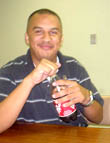|
|
This topic comprises 5 pages: 1 2 3 4 5
|
|
Author
|
Topic: Splicing Tape Preferences -- Opaque or Zebra
|
Rhys M. Blavier
Film Handler
Posts: 13
From: Richardson, Texas, USA
Registered: Jul 2004
|
 posted 01-31-2005 04:26 AM
posted 01-31-2005 04:26 AM




I would like to get opinions from other professional projectionists about their personal preferences for splicing tape. Specifically, between reels do you prefer to use opaque (yellow or white) or zebra (clear with yellow dashes) tape between reels.
I personally prefer to use opaque tape for several reasons. First, it is about half the cost of zebra tape. Second, zebra tape is clear tape with the dashes added and, in my opinion, the coloring used for the dashes has a horrible tendency to stain the film where it contacts for any length of time. Third (and, to me, the most important reason), in my experience, an audience member cannot tell when a an opaque splice has gone through any better than they can see cue dots so it is not a detriment to their viewing while on my end it speeds up my ability to find and remove the splices considerably.
Over the course of the last 20 or so years, I have specifically asked people I know who have NO projection experience to LOOK for splices going through. Even when I tell them what to look for, no one I have talked to has ever been bothered by opaque splices on a print. In a very rare instance, someone I have coached may see one on if they remember to look for them but all of them have told me that unless they are bored by the movie, it never occurs to them to watch for the splices and that they do not notice when a splice goes through.
On the other hand, when I am breaking down a print, especially when I am having to work fast, it is very easy to miss a zebra tape splice go through and I continually have to manually unwind to search for splices that go by without my seeing them. Opaque splices, however, are very easy for me to find and remove. Using opaque tape, my current best breakdown is two movies, 15 reels total (a 7-reel feature and an 8-reel feature), in just under an hour and a half. That is going from platters to 6000-foot reels on portable make-up tables, taking the 6000-foot reels to my base make-up table and then breaking down from the 6000-foot reels to individual 2000-foot reels. This is not something I could have accomplished if I had been having to search for my splices during break-downs.
So, to summarize, since cost, film care and speed factors all come out in favor of opaque tape on a consistent basis, while audience viewing is not noticeably or significantly improved by the use of zebra tape, I prefer, without reservation, to use opaque tape to make any and every slice which will later need to be removed. Does anyone else have any experiences, thoughts, opinions, etc. to support or to contradict my preferences?
| IP: Logged
|
|
|
|
|
|
Carl Martin
Phenomenal Film Handler
Posts: 1424
From: Oakland, CA, USA
Registered: Feb 2002
|
 posted 01-31-2005 05:08 AM
posted 01-31-2005 05:08 AM





rhys, trust me, you will get plenty bawled out for saying that on this site. clear tape is the way to go.
i do agree that most people will not notice splices, or any other non-cataclysmic defect for that matter, to the extent that they'd remember if you asked them afterwards. nevertheless their experience will be worse than it could be, for reasons they can't account for. i've seen many poor presentations, and i'm generally able to live with it. but when i see a great presentation, which is rare around here, it wows me. i can pinpoint many reasons why, but even if i couldn't, the wow would still be there.
part of our job should be training our audiences to know what film can deliver and to expect the best. check out don sneed's post in the japan thread to see maybe an extreme example of what i mean. too damn many people seem to think watching a video is just as good. that's the way they've been trained.
imagine the most perceptive, discriminating film viewer. imagine giving this person nothing to complain about. now try to make that happen.
carl
| IP: Logged
|
|
|
|
Brad Miller
Administrator

Posts: 17775
From: Plano, TX (36.2 miles NW of Rockwall)
Registered: May 99
|
 posted 01-31-2005 06:50 AM
posted 01-31-2005 06:50 AM




quote:
"I would like to get opinions from other professional projectionists...blah, blah, blah..."
Sorry, but if you are using opaque tape, you have no right to call yourself a professional. Most will also say that people using zebra tape have no right to be called a professional either, but occasionally you will find people who feel zebra is ok.
Still, all of the GOOD professional projectionists I know use clear tape exclusively. There really is no need for any marking on the print (or tape) of any sort.
You should also be breaking down directly onto the shipping reels off of the platter. Running onto 6000 foot reels and then breaking the film down further is just plain retarded. Not only is it an incredible waste of time, but you won't achieve the same quality wind on a rewind bench that can be obtained on a platter MUT.
Also your 90 minute record for 2 lengthy movies is pretty slow. Both could easily be done in 30-40 minutes tops if broken down properly (and this includes either clear tape or ultrasonic splices being used on the initial buildup).
Remember, you don't LOOK at the film while searching for splices, you FEEL the edges of the film for the splices. That's how professionals do it.
I do have one question for you though...who trained you??? They really need to be outed here.
| IP: Logged
|
|
|
|
|
|
|
|
|
|
|
|
Randy Stankey
Film God

Posts: 6539
From: Erie, Pennsylvania
Registered: Jun 99
|
 posted 01-31-2005 10:12 AM
posted 01-31-2005 10:12 AM




If you're worried about cost then you should stock clear tape and ONLY clear tape. You will only have to keep one item in inventory at any time, versus TWO items.
If you use opaque tape, zebra tape, splice-mark tape or any other item, you must also keep plain clear tape on hand as well. If you don't, how are you going to repair film if/when it breaks? How will you remove lab splices? Clear tape must be kept on hand in any professional booth. The use of opaque tape thereby necessitates the need to keep a SECOND kind of tape.
You will need to stock, inventory, order and PAY FOR a second kind of tape. Even if both kinds of tape are EXACTLY the same price you will STILL have to keep inventory on two products. The time and energy used to inventory two products equates to cost. (Time = Money.)
Using clear tape only is the only way to go. It's cheaper all the way around.
If you can't find a splice using clear tape you need to get with the program.
If you need to be able to tell the difference between repair/lab-splice repairs and splices between reels you can differentiate them with some kind of marking system. (Sharpie marker on the splice tape, etc., etc.)
Oh! And customers DO notice the difference between good splices and crummy ones. They just don't tell you about it in so many words. They just stop coming to your theater.
Case-In-Point: How many times have you heard somebody say, "I don't want to go to [some theater]. I always get a headache when I go there." (We've all heard this at least once, if we haven't said it ourselves.)
Why does it happen? Because something's wrong with the projector. A jittery picture or a dim lamp or a shutter out of time or one of 1,000,000 tiny little things could go wrong. Customers notice these things but they don't know WHY they happen. They only know they don't like getting a headache when they come to your theater.
Here's the thing... It may have happened ONE TIME several YEARS ago but because of CONFIRMATION BIAS they will seem to remember the one bad incident at your theater. The customer will tend to stay away from your theater.
The same thing happens with splices and other "little" things you don't think they notice. Poor focus, crappy sound, crummy splices... They all add up in the customer's brain. Even if they don't specifically remember that crappy splice they just won't be as "satisfied" with the movie.
People DO notice crappy splices! They just don't tell YOU. They just don't come back!
| IP: Logged
|
|
|
|
Monte L Fullmer
Film God

Posts: 8367
From: Nampa, Idaho, USA
Registered: Nov 2004
|
 posted 01-31-2005 02:09 PM
posted 01-31-2005 02:09 PM




..seems like we had a thread on this before on splicing and marking techniques.
Yeppers, using opaque (yellow or white) is just plain laziness and very unprofessional.
I don't use china markers, I use Edgemark tape (for I have to since our theatres have idiots who can't see very well), otherwise I'd be clear all the time with no markings whatsoever.
BUT.....if you're going to do the opaque thing, here is a trick to make the splices not so noticable:
when cutting the film: Cut each frame in half so you have two sprocket, half frame on each side of the splice line on the splicer. Then draw the yellow goop across this, and then you would be only covering up one complete frame and this is not as noticable as the conventional one and a half frame coverup, which is extremely annoying to see - like missing a changeover between every reel after the second cue.
You want to make your presentation as smooth and flowing as possible, for the audience is expecting a complete, uninterrupted show. Not "broken" apart with the black blip between reels. You don't see this "breaking" apart on video and DVD movies, so why not make your theatre presentations the same. (why the home theatre industry is taking off some-perfect presentations)
-Monte
| IP: Logged
|
|
|
|
|
|
All times are Central (GMT -6:00)
|
This topic comprises 5 pages: 1 2 3 4 5
|
Powered by Infopop Corporation
UBB.classicTM
6.3.1.2
The Film-Tech Forums are designed for various members related to the cinema industry to express their opinions, viewpoints and testimonials on various products, services and events based upon speculation, personal knowledge and factual information through use, therefore all views represented here allow no liability upon the publishers of this web site and the owners of said views assume no liability for any ill will resulting from these postings. The posts made here are for educational as well as entertainment purposes and as such anyone viewing this portion of the website must accept these views as statements of the author of that opinion
and agrees to release the authors from any and all liability.
|

 Home
Home
 Products
Products
 Store
Store
 Forum
Forum
 Warehouse
Warehouse
 Contact Us
Contact Us




 Printer-friendly view of this topic
Printer-friendly view of this topic





![[beer]](graemlins/beer.gif)





![[Confused]](confused.gif)



![[Big Grin]](biggrin.gif)


![[Frown]](frown.gif)



